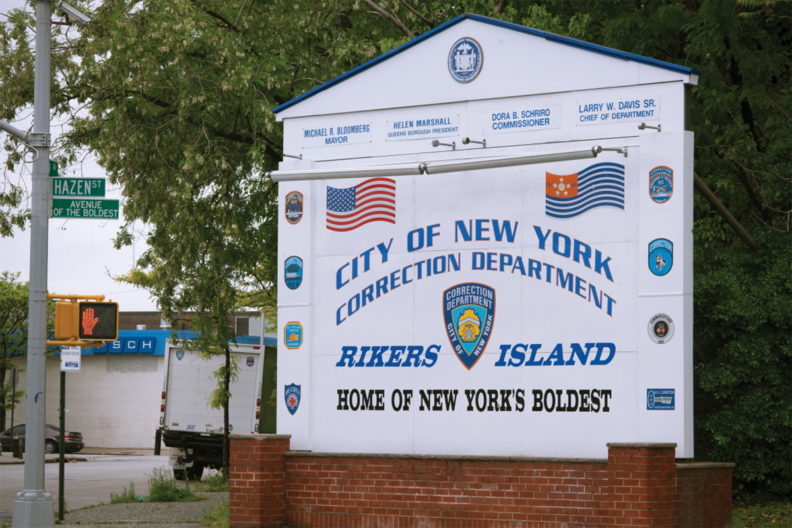Why Rikers Needs a Federal Receivership, and Why it Must Close for Good
The best way to end the abuses at Rikers is to make sure no one gets sent there again.

Every day, thousands of mostly Black and Brown New Yorkers’ lives are put in danger because they are locked up at New York City’s Rikers Island jail complex. The abuse, dysfunction, and violence at Rikers cost 19 people their lives in 2022 and nine have died there so far this year.
Even after eight years under the watchful eye of a federal monitor, conditions have not improved, and in many ways they’ve gotten worse. Nearly every week brings fresh horrors from the island where the vast majority of people there are legally innocent and awaiting trial. People forced to soil themselves because they aren’t allowed to use the bathroom; New Yorkers made to sleep on excrement-covered floors; slashings and stabbings surging; absentee guards who, when they do show up to work, often brutalize those they are supposed to protect. The list of horrors goes on and on, year after year.
New York City, under multiple administrations, has failed to fix the deep-seated problems that plague Rikers. That’s why, in a recently filed friend of the court brief, the NYCLU joins the calls of thousands of New Yorkers, the Rikers federal monitor, Manhattan’s top federal prosecutor and civil and human rights organizations in calling for a federal takeover of Rikers.
This takeover would come in the form of what’s called a receivership. Under a receivership, the city would be stripped of its authority over New York City jails. The receiver would be under a mandate – overseen by a federal judge – to end the dangerous and chaotic conditions at Rikers.
While a receiver is necessary to address the dire and unsafe conditions at Rikers, the ultimate solution is to permanently close the jail, as required by a city law passed in 2019. We argue that the receiver’s mandate to fix conditions at the jail is “fully consistent with compliance with the laws providing for the closure of Rikers Island.” Simply put, the best way to end the abuses at Rikers is to make sure no one gets sent there again.
We all want our city to be safe, and those who want to keep Rikers open forever appeal to this universal desire. But Rikers doesn’t make any one of us safer.
Under the 2019 law, Rikers is slated to be replaced by four smaller borough-based jails. For this plan to happen, the city must significantly reduce the jail population and ensure alternatives to incarceration are possible. Studies have repeatedly shown that locking up more people – especially in harrowing places like Rikers – does not make communities safer, and it puts the lives of incarcerated people at serious risk. This is true whether someone is incarcerated at Rikers or somewhere else.
There are people at Rikers who would benefit from rehabilitation, mental health care, and other services outside of a carceral setting. But no one is served by a situation in which people are put in traumatizing, violent places like Rikers, and then released into the community with no assistance.
Until the city finally closes Rikers, a federal receivership should also help bring much needed transparency to the tragic goings on at the jail. Under pressure to show improvements in jail conditions, Mayor Eric Adams’ administration has reacted, not by fixing the problems at Rikers, but by trying to cover them up.
The federal monitor reports that staff regularly fail to document brutality inside the jail, including deadly violence. These sorts of coverups and obfuscations are so common that the federal monitor recently said he had no confidence in the data on violent incidents provided by jail officials. And just last week, a lawsuit accused the recently-departed head of New York City’s jails with covering up violence at Rikers and retaliating against those who tried to expose it.
Adding to the lack of transparency, city officials announced in May that they would no longer publicly announce deaths that happen at Rikers. And in August, the Board of Correction – which helps oversee the city’s jails – sued the Department of Correction after the DOC cut off the Board’s access to live video footage from inside Rikers. After the lawsuit was filed, the Department of Correction restored the Board’s access to the footage.
Full transparency is essential for fixing the grave violations that permeate Rikers Island and for supporting efforts to close the jail. The receiver should regularly put out detailed and robust reports available to the public about conditions inside Rikers. The receiver should also publish information and databases on misconduct complaints, investigations, disciplinary proceedings and outcomes, and all uses of force at the jail. This transparency will help keep New Yorkers informed about what’s happening at Rikers, and further build the case for its closure.
We all want our city to be safe, and those who want to keep Rikers open forever appeal to this universal desire. But Rikers doesn’t make any one of us safer. New York City needs better mental health care, more affordable housing, more quality jobs, violence interruption programs, and services for survivors of crime. It does not need to subject thousands of New Yorkers – almost all of whom will be released at some point – to one of the deadliest jails in the country.
